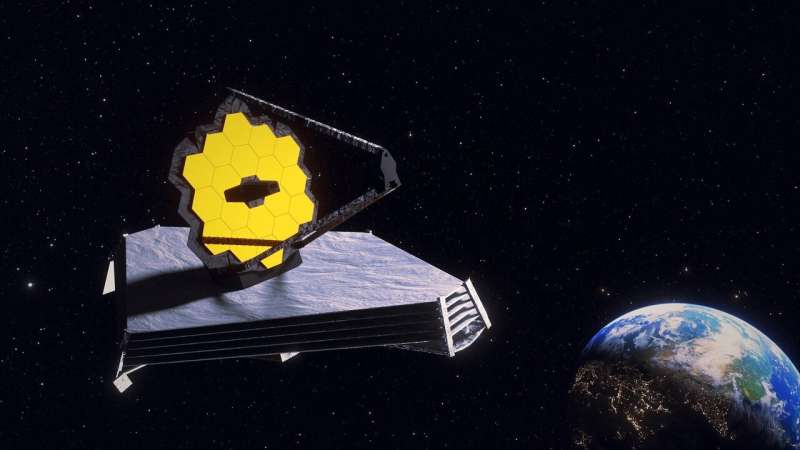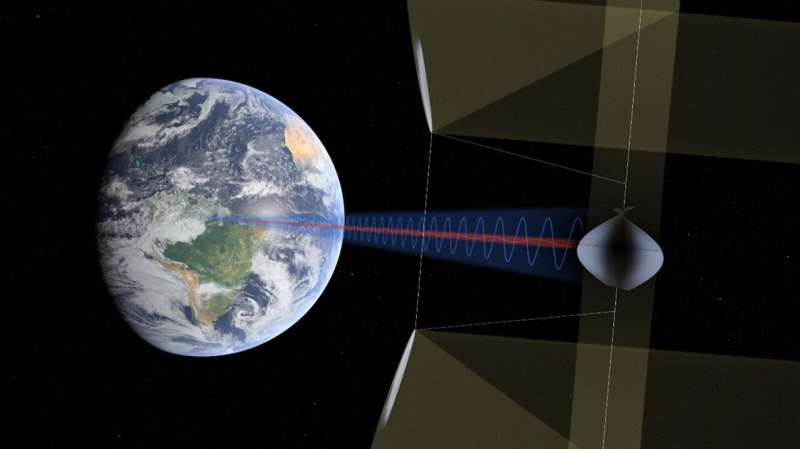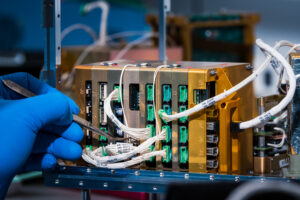Webb Telescope completes first multi-instrument alignment
Monday, 04 April 2022 12:19
The sixth stage of aligning NASA's James Webb Space Telescope's mirrors to its scientific instruments so they will create the most accurate and focused images possible has concluded. While the Mid-Infrared Instrument (MIRI) continues its cooldown, optics teams have successfully aligned the rest of the observatory's onboard instruments to Webb's mirrors. Previous alignment efforts were so accurate that the team concluded no additional adjustments to the secondary mirror are necessary until the seventh and final stage, which will involve MIRI when it has fully cooled.
"As a general rule, the commissioning process starts with coarse corrections and then moves into fine corrections. The early secondary mirror coarse corrections, however, were so successful that the fine corrections in the first iteration of Phase Six were unnecessary," said Chanda Walker, Webb wavefront sensing and control scientist, Ball Aerospace. "This accomplishment was due to many years of planning and great teamwork among the wavefront sensing team."
Throughout the majority of the alignment process, Webb's 18 hexagonal mirrors and secondary mirror were focused into alignment to the Near-Infrared Camera (NIRCam) instrument only.
Download the free April issue of SpaceNews magazine
Monday, 04 April 2022 11:40
Download the free April issue of SpaceNews magazine
The post Download the free April issue of SpaceNews magazine appeared first on SpaceNews.
Solar-power satellites to collect stronger sunlight
Monday, 04 April 2022 11:40
Solar energy generation keeps on becoming cheaper and more efficient, but some basic limitations will always apply: solar panels can only generate power during the daytime, and much of the sunlight is absorbed by the atmosphere as it shines downward. So ESA is working on the concept of collecting solar power up in orbit, where sunlight is up to 11 times more intense than across European territory, then beaming it down to the ground for use.
As part of that effort, a new project looks into designing solar-power satellites, which would become the largest structures ever built in space. Frazer-Nash Consultancy will study the modular construction of solar-power satellites, to efficiently disassemble them as they come to their end-of-life for reuse or recycling.
Explore further
Lockheed Martin releases open-source satellite interface for on-orbit docking
Monday, 04 April 2022 11:31
Lockheed Martin on April 4 released the technical specifications of a docking adapter that could be used by manufacturers to make satellites interoperable and easier to update on orbit with new technology.
Telesat gets security clearance to serve US government directly
Monday, 04 April 2022 10:00
Canada’s Telesat said April 4 it has gained the security clearances it needs to sell directly to U.S. government customers.
The post Telesat gets security clearance to serve US government directly appeared first on SpaceNews.
The space arms race keeps accelerating, new reports warn
Monday, 04 April 2022 09:00
As space becomes increasingly important to terrestrial activities, the tools and weapons available to disrupt and damage satellites are proliferating around the world, according to two reports released April 4.
The post The space arms race keeps accelerating, new reports warn appeared first on SpaceNews.
Space experiment to push standardization in small satellites
Monday, 04 April 2022 09:00
An experiment scheduled to launch this fall on Virgin Orbit’s LauncherOne rocket will try to show a faster and cheaper way for the space industry to test technologies on orbit.
The post Space experiment to push standardization in small satellites appeared first on SpaceNews.
NASA scrubs first attempt at SLS countdown rehearsal
Sunday, 03 April 2022 16:35
NASA called off the first attempt to fuel its Space Launch System rocket and go through a practice countdown April 3, citing a problem with the rocket’s mobile launcher.
The post NASA scrubs first attempt at SLS countdown rehearsal appeared first on SpaceNews.
Rogozin delays decision on space station future
Sunday, 03 April 2022 15:34
After Western nations refused his demand to end sanctions on Russian companies involved in the International Space Station, the head of Roscosmos said he will make recommendations in the “near future” on Russia’s continued participation in the station, but there are no signs of any near-term changes in station operations.
Private mission ready for launch to the ISS
Sunday, 03 April 2022 13:22
The first private mission to the International Space Station by an American vehicle is scheduled to launch this week to serve as a first step in one company’s plans to establish a commercial space station.
Russian space agency suspends ISS cooperation over sanctions
Sunday, 03 April 2022 04:10 Russia has suspended cooperation with other nations involved with the International Space Station over sanctions levied amid the war in Ukraine.
Dmitry Rogozin, the director-general of Russian space agency Roscosmos, made the announcement in a series of tweets Saturday in response to a letter received from NASA Administrator Bill Nelson, a former U.S. senator.
Nelson said in a le
Russia has suspended cooperation with other nations involved with the International Space Station over sanctions levied amid the war in Ukraine.
Dmitry Rogozin, the director-general of Russian space agency Roscosmos, made the announcement in a series of tweets Saturday in response to a letter received from NASA Administrator Bill Nelson, a former U.S. senator.
Nelson said in a le Rocket Lab launches 112th satellite to orbit
Sunday, 03 April 2022 04:10 Rocket Lab USA, Inc (Nasdaq: RKLB), a leading launch and space systems company, has successfully deployed two satellites to orbit for real-time geospatial intelligence company BlackSky (NYSE: BKSY), bringing the total number of satellites deployed by Rocket Lab to 112.
The 'Without Mission A Beat' mission, arranged for BlackSky through global launch services provider Spaceflight Inc., was
Rocket Lab USA, Inc (Nasdaq: RKLB), a leading launch and space systems company, has successfully deployed two satellites to orbit for real-time geospatial intelligence company BlackSky (NYSE: BKSY), bringing the total number of satellites deployed by Rocket Lab to 112.
The 'Without Mission A Beat' mission, arranged for BlackSky through global launch services provider Spaceflight Inc., was Successful launch shows new rocket factory's solid steps
Sunday, 03 April 2022 04:10 China launched a Long March 11 solid-propellant carrier rocket on Wednesday morning from the Jiuquan Satellite Launch Center in Northwest China, deploying three satellites into space, according to China Aerospace Science and Technology Corp (CASC).
The rocket blasted off at 10:29 am and soon placed the Tianping 2A, 2B and 2C satellites into their planned orbit. The launch was the 413th fli
China launched a Long March 11 solid-propellant carrier rocket on Wednesday morning from the Jiuquan Satellite Launch Center in Northwest China, deploying three satellites into space, according to China Aerospace Science and Technology Corp (CASC).
The rocket blasted off at 10:29 am and soon placed the Tianping 2A, 2B and 2C satellites into their planned orbit. The launch was the 413th fli HawkEye 360 launches next-generation Cluster 4 satellites
Sunday, 03 April 2022 04:10 HawkEye 360 Inc., the world's leading commercial provider of space-based radio frequency (RF) data and analytics, reports that its Cluster 4 satellites have successfully launched aboard a SpaceX Falcon 9 rocket from the Cape Canaveral site on April 1. The trio of HawkEye 360 satellites, each containing an RF payload developed by HawkEye 360, has established communication with ground control and
HawkEye 360 Inc., the world's leading commercial provider of space-based radio frequency (RF) data and analytics, reports that its Cluster 4 satellites have successfully launched aboard a SpaceX Falcon 9 rocket from the Cape Canaveral site on April 1. The trio of HawkEye 360 satellites, each containing an RF payload developed by HawkEye 360, has established communication with ground control and D-Orbit Launches its Fifth ION Satellite Carrier Mission
Sunday, 03 April 2022 04:10 D-Orbit, the space logistics and orbital transportation company, has launched Spacelust, the fifth mission of the Company's proprietary ION Satellite Carrier (ION), aboard SpaceX's Transporter-4 mission. The Falcon 9 rocket lifted off April 1, 2022, at 12:24 PM EDT from the Space Launch Complex 40 (SLC-40) at Cape Canaveral Space Force Station (CCSFS), Florida. ION, a versatile and cost-effectiv
D-Orbit, the space logistics and orbital transportation company, has launched Spacelust, the fifth mission of the Company's proprietary ION Satellite Carrier (ION), aboard SpaceX's Transporter-4 mission. The Falcon 9 rocket lifted off April 1, 2022, at 12:24 PM EDT from the Space Launch Complex 40 (SLC-40) at Cape Canaveral Space Force Station (CCSFS), Florida. ION, a versatile and cost-effectiv 
